
Amaryllis is the only genus in the subtribe Amaryllidinae. It is a small genus of flowering bulbs, with two species. The better known of the two, Amaryllis belladonna, is a native of the Western Cape region of South Africa, particularly the rocky southwest area between the Olifants River Valley and Knysna. For many years there was confusion among botanists over the generic names Amaryllis and Hippeastrum, one result of which is that the common name "amaryllis" is mainly used for cultivars of the genus Hippeastrum, widely sold in the winter months for their ability to bloom indoors. Plants of the genus Amaryllis are known as belladonna lily, Jersey lily, naked lady, amarillo, Easter lily in Southern Australia or, in South Africa, March lily due to its propensity to flower around March. This is one of numerous genera with the common name "lily" due to their flower shape and growth habit. However, they are only distantly related to the true lily, Lilium. In the Victorian Language of Flowers, amaryllis means "pride, determination and radiant beauty".

Chives, scientific name Allium schoenoprasum, is a species of flowering plant in the family Amaryllidaceae that produces edible leaves and flowers. Their close relatives include the common onions, garlic, shallot, leek, scallion, and Chinese onion.

Allium tuberosum is a species of plant native to the Chinese province of Shanxi, and cultivated and naturalized elsewhere in Asia and around the world.

Allium monanthum, the Korean wild chive, is a spring vegetable with minuscule bulbous roots that have a mild onion flavor and found in the woodlands of Korea, Japan, northeastern Russia (Primorye), and northeastern China.

Allium nigrum, common name black garlic, broad-leaved leek, or broadleaf garlic, is a Middle Eastern species of wild onion. It lacks the onion or garlic scent shared by most of the other species in the group. The species is native to Turkey, Cyprus, Syria, Lebanon, and Israel but cultivated as an ornamental in many other places. It has become naturalized in some regions, including parts of the United States.

Allium cristophii, the Persian onion or star of Persia, is a species of flowering plant in the family Amaryllidaceae, native to Iran, Turkey, and Turkmenistan, though grown as an ornamental bulbous plant in many parts of the world. It may be sold under the synonym of Allium albopilosum.

Allium textile is a common species of wild onion found in the central part of North America.

Allium stipitatum, Persian shallot, is an Asian species of onion native to central and southwestern Asia.
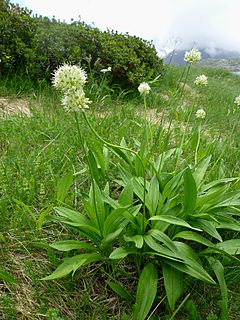
Allium victorialis, commonly known as victory onion, Alpine leek, and Alpine broad-leaf allium is a broad-leaved Eurasian species of wild onion. It is a perennial of the Amaryllis family that occurs widely in mountainous regions of Europe and parts of Asia.
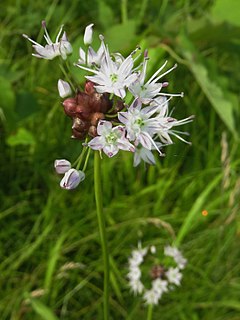
Allium macrostemon, English name long-stamen chive, is a species of wild onion widespread across much of East Asia. It is known from many parts of China, as well as Japan, Korea, Mongolia, Tibet and Primorye. It has been collected from elevations ranging from sea level to 3000 m.
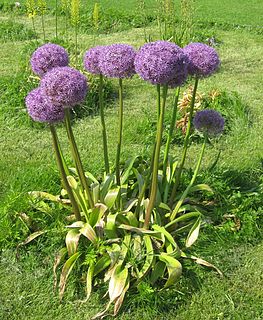
Allium hollandicum, the Persian onion or Dutch garlic, is a species of flowering plant native to Iran and Kyrgyzstan but widely cultivated as an ornamental because of its umbels of attractive purple flowers. It is reportedly naturalized in Saint Louis County, Minnesota.

Allium atroviolaceum is a species of flowering plant in the Amaryllidaceae family. it is commonly called the broadleaf wild leek, and is native to Iran, Iraq, Afghanistan, Syria, Lebanon, Saudi Arabia, Turkmenistan, Turkey, Georgia, Armenia, Azerbaijan, southern European Russia and the Caucasus, but widely cultivated in other regions as a food source and for its ornamental value. The species is sparingly naturalized in parts of the United States and also in southeastern Europe.

Allium ramosum, called Fragrant-flowered Garlic or Chinese chives is a northern Asian species of wild onion native to Kazakhstan, Mongolia, Siberia, the Russian Far East, and northern China. The species is also naturalized in a few places in eastern Europe. In its native range, it grows at elevations of 500–2100 m.

Allium schubertii, which has various common names including ornamental onion, flowering onion, tumbleweed onion and Persian onion, is a species of monocotyledonous flowering plant from the onion and garlic genus, in the subfamily Allioideae part of the Amaryllidaceae which occurs in the Levant and Libya.
Allium stocksianum is a species of flowering plant in the Amaryllidaceae family. It is native to Pakistan, Afghanistan and Iran. It is a perennial herb up to 15 cm tall, with a bulb up to 20 mm across. Umbels are hemispherical, up to 5 cm across, with pink to purple flowers.

Gilliesieae is a tribe of herbaceous geophyte plants belonging to the subfamily Allioideae of the Amaryllis family (Amaryllidaceae). Described in 1826, it contains fifteen genera and about eighty species. It has been variously treated as a subfamily or tribe. It is native to the Southern United States, Central and South America, predominantly Chile. Of the three tribes of genera that make up the subfamily Allioideae, Gilliesieae is the largest and most variable. The tribe was divided into two tribes in 2014, Gilliesiae s.s. and Leucocoryneae, based on differences in floral symmetry and septal nectaries.
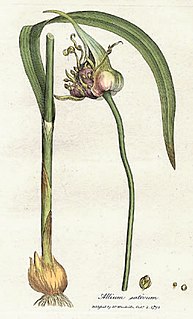
Allium is a genus of monocotyledonous flowering plants that includes hundreds of species, including the cultivated onion, garlic, scallion, shallot, leek, and chives. The generic name Allium is the Latin word for garlic, and the type species for the genus is Allium sativum which means "cultivated garlic".
Allium dregeanum is the sole known species of Allium endemic to sub-Saharan Africa. It has also been described as the only Allium species endemic to the Southern Hemisphere, though some descriptions of the genus also include Allium juncifolium (Chile) and Allium sellovianum (Brazil), which are much less studied than Allium dregeanum. The distribution of Allium dregeanum extends from the summer-rainfall region, into the winter-rainfall zone of South Africa. Since Allium species are almost exclusively found in the Northern Hemisphere, with major centers of diversity in Central Asia and western North America, the biogeographical history of Allium dregeanum is of interest.
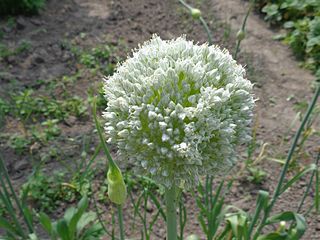
The precise taxonomy of the genus Allium is still poorly understood with incorrect descriptions being widespread. With over 850 species distributed over the Northern hemisphere Allium is the sole genus in the Allieae, one of four tribes of subfamily Allioideae (Amaryllidaceae). New species continue to be described and Allium is both highly variable and one of the largest monocotyledonous genera, but the precise taxonomy of Allium is poorly understood, with incorrect descriptions being widespread. The difficulties arise from the fact that the genus displays considerable polymorphism and has adapted to a wide variety of habitats. Furthermore, traditional classications had been based on homoplasious characteristics. However, the genus has been shown to be monophyletic, containing three major clades, although some proposed subgenera are not. Some progress is being made using molecular phylogenetic methods, and the internal transcribed spacer (ITS) region, including the 5.8S rDNA and the two spacers ITS1 and ITS2, is one of the more commonly used markers in the study of the differentiation of the Allium species.
Allium akirense is a species of flowering plant in the family Amaryllidaceae endemic to Israel. Is it closely related to Allium qasyunense. It is diploid having 14 chromosomes.
















